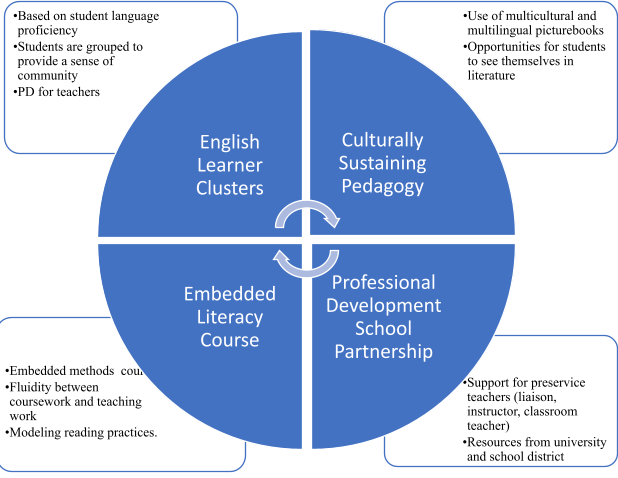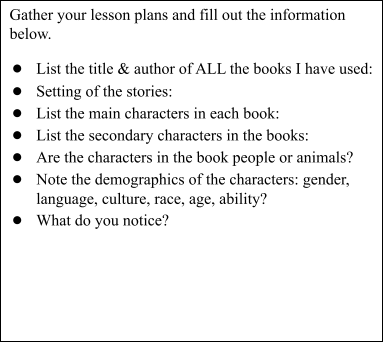Embedded Classrooms, Culturally Sustaining Pedagogy, and Growing Early Childhood Literacy Educators
Julia López-Robertson, Jennifer D. Morrison, India Grady, Joan Morgan, and DeAnna Savage
We are two classroom teachers (India, first grade and Joan, fifth grade), an assistant principal (DeAnna), and two university faculty members (Julia and Jennifer) from the University of South Carolina. Together we form the Professional Development team at Pontiac Elementary School. As members of the National Association of Professional Development Schools (NAPDS) network, our school-university partnership is committed to the preparation of future educators who embrace their active engagement in the school community. As such, we actively engage preservice teachers in working within classrooms with teachers and students.
Professional Development School Partnership
The figure below (Figure 1) explains the relational nature of our partnership; the PDS partnership provides the opportunity to support preservice teachers and classroom teachers with resources from the university. The embedded coursework provides fluidity between coursework and the actual work of teaching, with the ECE literacy methods courses focused on culturally sustaining pedagogy as enacted through multicultural and multilingual picturebooks. The focus of this vignette is the embedded literacy methods course and culturally sustaining pedagogical practices taught through the use of picturebooks.
English Learner Clusters
Pontiac Elementary serves approximately 700 students in PreK-5 with demographics as follows: 67% receive free/reduced lunch, 18% are identified as White, 2% Asian, 58% Black or African American, 5% two or more races, and 15% Hispanic/Latinx. In the fall of 2018, Pontiac initiated clusters to better serve children who are English Learners (EL). The clusters, based on student language proficiency, group ELs in classrooms to provide them with a sense of community, assign no more than 50% of ELs in one class, and offer PD and support for teachers. Mrs. Grady and Mrs. Morgan teach first and fifth grade in the EL cluster.
Embedded Literacy Course
As a part of an embedded literacy course, we offer preservice teachers (PST) a context for understanding the link between theory and practice (Zeichner, 2010), which is particularly important when working with diverse student populations. Course goals include developing understandings about theory and practice in literacy education by focusing on the teaching and learning of reading by developing, implementing, and evaluating lesson plans to support young children’s literacy learning and develop supportive classroom environments and practices for young children (birth through age eight) as readers across linguistic and cultural communities.
Preservice teachers were paired with students from Mrs. Grady’s and Mrs. Morgan’s classes. PSTs created standards-based lessons and engaged the children in one-to-one lessons for 45 minutes weekly where they “examined a practice, observed examples of the practice in action, tried it out, and with feedback reflected upon their enactment of practice,” which informed their teaching (Dubetz & Collette, 2020, p. 2). While the PSTs were working with the children, Jennifer and Julia walked around and observed, took notes, and sometimes engaged with the students in the lessons. A whole group sharing time ended our time together after which the children returned to their classrooms, and the preservice teachers debriefed with Jennifer and Julia. The debriefing provided real-time feedback which positively impacted lesson planning buy PSTs and enhanced their understanding of the connection between theory and practice. It also allowed PSTs to ask questions and receive guidance immediately at point of use.
Culturally Sustaining Pedagogy
We share a belief in a culturally sustaining pedagogy (Paris & Alim, 2014) where schools must locate the “linguistic, literate, and cultural practices of working-class communities–specifically poor communities of color–as resources and assets to honor, explore, and extend” (p. 87) and enact these practices through explorations and reiterative engagements with multicultural and multilingual picturebooks with preservice teachers and children.
A few weeks into the semester, while reviewing lesson plans and field notes taken during observations of the PSTs teaching, Julia noticed the book selections PSTs were overwhelmingly choosing familiar books they loved as children such as If You Give a Moose a Muffin (Numeroff, 1991) and The Very Hungry Caterpillar (Carle, 1994). This was the first time the PSTs were responsible for creating and implementing lessons, and, understandably, they selected books they knew. Julia spoke with Jennifer, and they decided to focus the next debriefing on book selection. However, rather than tell the PSTs that they needed to alter their book selection, Julia asked the PSTs to gather their lesson plans and fill out a Book Selection Analysis form (Figure 2).
Once the PST completed their forms, they paired up and talked about what they noticed in their individual analysis. We then gathered for a whole class discussion. PSTs were surprised to find they were choosing similar titles and their heavy reliance on Dr. Suess, Eric Carle, and the Purplicious (Kann & Kann, 2007) series. At this time, Julia showed the graphic from the Cooperative Children’s Book Center, Diversity in Children’s Books 2018, (Figure 3) that notes the percentage of books depicting characters from diverse backgrounds. Of the 3134 books published in the United States in 2018, 50% depicted White and 27% were about animals. The remaining 23% of books were divided as follows; 10% of books reflected African American 7%; Asian Pacific Islander/Asian Pacific American; 5% Latinx, and 1% American Indian/First Nations. PSTs were surprised that “there are more books about animals than there are about people of color!” They were also surprised that their book selection closely reflected the graphic.
And then COVID came along…
Our semester was cut short due to COVID, but as we continued to work with the children through video lessons, the PSTs sought out books that were multilingual and/or culturally diverse. Several of the PSTs even chose bilingual books–written in English and Spanish–and read them in Spanish to the children. During one of the online class meetings, Julia introduced the PSTs to a few websites that provided support with book selection; for example the Cooperative Children’s Book Center Recommended Book Search, Worlds of Words and Epic books for kids. PSTs worked in small groups to explore the websites and search for books upon which they based their video lessons. Some of the titles they selected were What Can You Do with a Rebozo?/¿Qué puedes hacer con un rebozo? (Tafolla, 2009); What can you do with a Paleta?/¿Qué Puedes Hacer con una Paleta? (Tafolla, 2014) and I Love Saturdays y domingos (Ada, 2004). PSTs talked about how nervous they felt in making mistakes in pronunciation and connected this with the way English Learners often feel in school. One PST shared that she had gone on to Epic.com and listened to the read aloud of The Cazuela that the Farm Maiden Stirred (Vamos, 2013) because she wanted to “hear the way the words sounded in Spanish so that I wouldn’t sound too strange to my Amiguito.”
Asking the PSTs to do the Book Selection Analysis rather than tell them about their book selection provided them with the opportunity to see for themselves the choices they were making when it came time to select picturebooks and the subsequent possible impacts of those choices. Their engaging in the work meant more to them than being told they were missing representations of entire populations of children.
Our work as a PDS Partnership provides PSTs with the opportunity to work with children while being supported by university instructors and classroom teachers and to receive immediate feedback on their teaching. The partnership offers children the opportunities to share their learning and to strengthen their ELA strategies and skills while working individually with a PST who is able to personalize their learning experiences.
Children’s Literature Cited
Ada, A. F. (2004). I love Saturdays y domingos (E. Savadier, illus.). Atheneum.
Carle, E. (1994). The very hungry caterpillar. World of Eric Carle.
Kann, V., & Kann, E. (2007). Purplicious (V. Kann, illus.). HarperCollins.
Numeroff, L. (1991). If you give a moose a muffin (F. Bond, illus.). HarperCollins.
Tafolla, C. (2009). What can you do with a paleta?/¿Qué puedes hacer con una paleta? (M. Morales, illus.). Dragonfly Books.
Tafolla, C. (2009). What can you do with a rebozo?/¿Qué puedes hacer con un rebozo? (M. Morales, illus.). Dragonfly Books.
Vamos, S. R. (2013). The Cazuela that the farm maiden stirred (R. López, illus.). Charlesbridge.
References
Cooperative Children’s Book Center (n.d.). Books by and/or about Black, Indigenous and People of Color 2018-. https://ccbc.education.wisc.edu/literature-resources/ccbc-diversity-statistics/books-by-and-or-about-poc-2018/.
Cooperative Children’s Book Center (n.d.). CCBC-Recommended Book Search. https://ccbc.education.wisc.edu/recommended-books/.
Dubetz, N., & Collett, J. (2020). Studying program effectiveness in preparing teachers for English Learners. Action in Teacher Education, 42(3), 190-211.
Huyck, David and Sarah Park Dahlen. (2019 June 19). Diversity in Children’s Books 2018. sarahpark.com blog. Created in consultation with Edith Campbell, Molly Beth Griffin, K. T. Horning, Debbie Reese, Ebony Elizabeth Thomas, and Madeline Tyner, with statistics compiled by the Cooperative Children’s Book Center, School of Education, University of Wisconsin-Madison: https://ccbc.education.wisc.edu/literature-resources/ccbc-diversity-statistics/books-by-about-poc-fnn/. Retrieved from https://readingspark.wordpress.com/2019/06/19/picture-this-diversity-in-childrens-books-2018-infographic/.
Paris, D., & Alim, H.S. (2017). Culturally sustaining pedagogies: Teaching and learning for justice in a changing world. Teachers College Press.
Worlds of Words (n.d.). World of Words Booklists. https://wowlit.org/links/booklists/.
Zeichner, K. (2010). Rethinking the connections between campus courses and field experiences in college-and university-based teacher education. Journal of Teacher Education, 61(1-2), 89-99.
Julia López-Robertson is a Professor of Instruction and Teacher Education at the University of South Carolina. (ORCID https://orcid.org/0000-0002-7776-8179)
Jennifer D. Morrison is an Instructor of Teacher Education at the University of South Carolina. (ORCID https://orcid.org/0000-0001-9184-3406)
India Grady is a first-grade teacher at Pontiac Elementary School in Columbia, South Carolina.
Joan Morgan is a fifth-grade teacher at Pontiac Elementary School in Columbia, South Carolina.
DeAnna Savage is an assistant principal and serves as the PDS administrator at Pontiac Elementary School in Columbia, South Carolina.
© 2021 by Julia López-Robertson, Jennifer D. Morrison, India Grady, Joan Morgan, and DeAnna Savage
WOW Stories, Volume IX, Issue 1 by Worlds of Words is licensed under a Creative Commons Attribution-NonCommercial-ShareAlike 4.0 International License.
Based on a work by Julia López-Robertson, Jennifer D. Morrison, India Grady, Joan Morgan, and DeAnna Savage at https://wowlit.org/on-line-publications/stories/volume-ix-issue-1/7/.
WOW stories: connections from the classroom
ISSN 2577-0551



